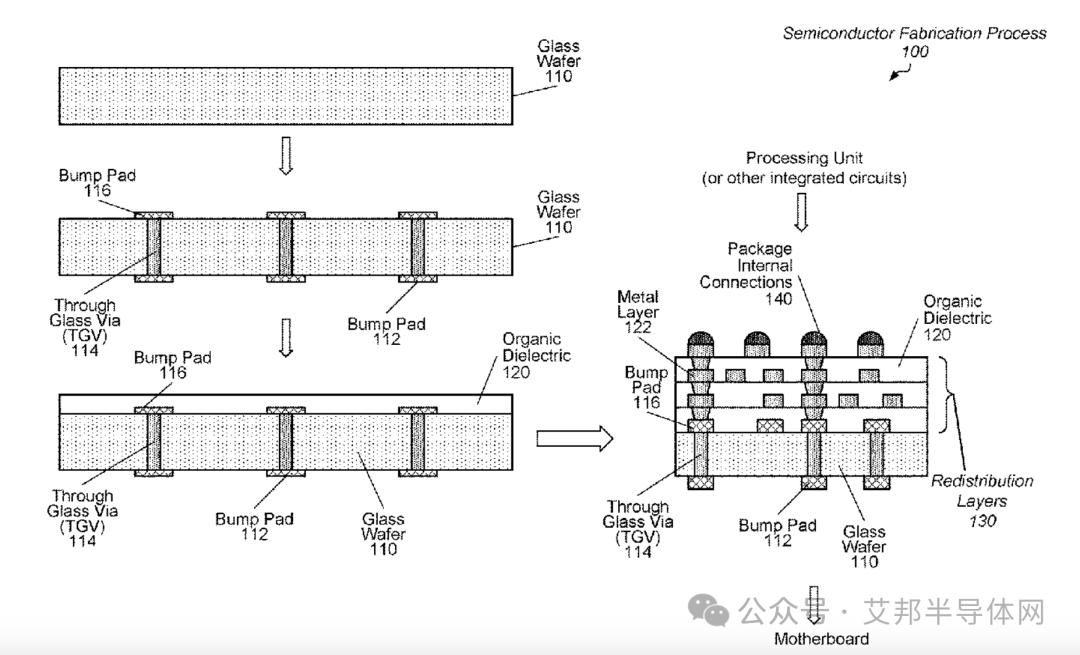AMD 已获得一项专利 ( 12080632 ),该专利涵盖玻璃核心基板技术。未来几年,玻璃基板将取代多芯片处理器的传统有机基板。这项专利不仅意味着 AMD 已广泛研究了相关技术,还将使该公司未来能够使用玻璃基板,而不必担心专利流氓或竞争对手起诉它。
AMD has been granted a patent (12080632) that covers glass core substrate tech. Glass substrates will replace traditional organic substrates for multi-chiplet processors in the coming years. The patent not only means AMD has worked on appropriate technologies extensively but will enable the company to use glass substrates in the future without risks that a patent troll or competitors could sue it.

图源:英特尔
包括英特尔 和 三星在内的大多数芯片制造商 都在探索未来处理器的玻璃基板。尽管 AMD 不再生产自己的芯片,而是将其外包给台积电,但它仍然拥有硅片和芯片生产研发业务,因为该公司根据合作伙伴提供的工艺技术定制产品。
Most chipmakers, including Intel and Samsung, are exploring glass substrates for future processors. Although AMD no longer produces its own chips, instead subcontracting them out to TSMC, it still has silicon and chip production research and development operations as the company customizes process technologies offered by its partners to build its products.
玻璃基板由硼硅酸盐、石英和熔融石英等材料制成,与传统有机材料相比,它们具有显著的优势,因为它们具有出色的平整度、尺寸稳定性以及优异的热稳定性和机械稳定性。优异的平整度和尺寸稳定性可以改善先进系统级封装中超密集互连的光刻聚焦,而优异的热稳定性和机械稳定性使它们在数据中心处理器等高温、重型应用中更加可靠。
Glass substrates are made from materials like borosilicate, quartz, and fused silica, which provide notable benefits compared to traditional organic materials as they feature exceptional flatness, dimensional stability, and superior thermal and mechanical stability. Superior flatness and dimensional stability can improve lithography focus for ultra-dense interconnects in advanced system-in-packages, whereas superior thermal and mechanical stability makes them more reliable for high-temperature, heavy-duty applications like data center processors.
根据 AMD 的专利,使用玻璃基板时面临的挑战之一是实施玻璃通孔 (TGV)。TGV 是在玻璃芯内创建的垂直通道,用于传输数据信号和电力。激光钻孔、湿法蚀刻和磁性自组装等技术可用于制作这些通孔,但目前,激光钻孔和磁性自组装是相当新颖的技术。

One of the challenges when working with glass substrates is the implementation of Through Glass Vias (TGVs), according to the AMD patent. TGVs are vertical pathways created within the glass core to transmit data signals and power. Techniques such as laser drilling, wet etching, and magnetic self-assembly are utilized to produce these vias, but for now, laser drilling and magnetic self-assembly are fairly novel technologies.
再分布层(RDL)是先进芯片封装的另一个组成部分,它使用高密度互连在芯片和外部组件之间路由信号和电源。与主玻璃芯基板不同,RDL将继续使用有机介电材料和铜;只是这一次它们将构建在玻璃晶片的一侧,需要一种新的生产方法。

这是一个详细的玻璃晶圆通孔(TGVs)制造过程,下面是每个步骤的翻译:
1. 在玻璃晶圆中蚀刻通孔空间
Etch space for vias in glass wafer.
2. 填充导电材料以形成通孔玻璃基板(TGVs)
Fill space with conductive material to form through glass vias (TGVs).
3. 在TGVs顶部形成焊盘
Form pads on top of the TGVs.
4. 在焊盘和玻璃晶圆顶部沉积有机介电材料
Deposit organic dielectric on top of the pads and the glass wafer.
5. 形成重分布层的信号路径
Form paths for signal routes of a redistribution layer.
6. 用金属层填充路径
Fill the paths with a metal layer.
7. 在金属层和先前的有机介电层上沉积有机介电材料
Deposit organic dielectric on top of the metal layer and previous organic dielectric.
8. 从金属层形成通孔至有机介电层顶部
Form vias from the metal layers to the top of the organic dielectric.
9. 在通孔顶部形成内部封装连接
Form internal package connections on the top of the vias.
以上是整个工艺流程的详细步骤翻译,涵盖了从开始蚀刻玻璃晶圆到形成内部连接的完整过程。
Redistribution layers — which route signals and power between the chip and external components using high-density interconnections — are another integral component of advanced chip packages. Unlike main glass core substrates, these will continue to use organic dielectric materials and copper; only this time will they be constructed on one side of the glass wafer, requiring a new production method.
该专利还描述了一种使用铜基键合(而不是传统的焊料凸块)来键合多个玻璃基板的方法,以确保牢固、无间隙的连接。这种方法提高了可靠性,并且无需使用底部填充材料,因此适合堆叠多个基板。
The patent also describes a method for bonding multiple glass substrates using copper-based bonding (instead of traditional solder bumps) to ensure strong, gap-free connections. This approach enhances reliability and eliminates the need for underfill materials, making it suitable for stacking multiple substrates.
虽然AMD的专利中明确指出玻璃基板具有更好的热管理、机械强度和改进的信号路由能力等优点,这对于数据中心处理器来说是一个优势,但该专利暗示玻璃基板可以应用于各种需要高密度互连的应用,包括数据中心、移动设备、计算系统,甚至先进的传感器,这似乎有点过头。
While AMD's patents clearly state that glass substrates offer such benefits as better thermal management, mechanical strength, and improved signal routing capabilities, which are advantages for data center processors, the patent implies that glass substrates could be applied to a variety of applications requiring high-density interconnections, including data center, mobile devices, computing systems, and even advanced sensors, which seems a bit overkill.
来源:Tom's Hardware
欢迎加入艾邦TGV玻璃基板产业链交流群,索取专利原文。诚邀您加入“玻璃基板与TGV技术交流群”,与行业精英共同探讨玻璃基板及TGV技术的前沿动态,共享资源,交流经验。在这里,您可以第一时间获取技术革新信息,深入解析行业趋势,与行业领袖面对面交流,共同推动技术革新,探索无限商机。

活动推荐:
主要议题(包含但不限于):
| 1.玻璃基板封装技术的最新进展与未来展望 |
| 2.TGV 玻璃关键技术面临的挑战及其解决策略 |
| 3.玻璃衬底材料与先进封装 |
| 4.玻璃衬底材料的本构模型、破坏机理及其在工程中的应用 |
| 5.先进封装产业升级中玻璃基互连技术的作用 |
| 6.玻璃基板生产的可靠性探讨 |
| 7.最新一代 TGV 玻璃通孔技术助力先进封装 |
| 8.激光系统在 TGV 中应用及发展 |
| 9.PLASMA 技术在 TGV 加工中应用 |
| 10.面板级玻璃基板的激光诱导蚀刻 & AOI |
| 11.飞秒激光助力先进封装玻璃基板发展 |
| 12.显微镜在半导体先进封装缺陷检测中的应用 |
| 13.TGV 填孔电镀配方及工艺 |
| 14.印刷铜浆与电镀铜优劣分析 |
| 15.PVD 技术在玻璃基板先进封装制程应用 |
| 16.在玻璃基板上开发湿化学铜金属化工艺 |
| 17.异构封装中金属化互联面临的挑战 |
| 18.高效RDL制造技术:赋能多种互联结构的面板级封装 |
| 19.TGV金属线路制作的工艺难点及技术解决路径 |
| 20.玻璃基板介电层材料研究 |
报名方式一:加微信
李小姐:18124643204(同微信)
邮箱:lirongrong@aibang.com
扫码添加微信,咨询展会详情

注意:每位参会者均需要提供信息

或者复制网址到浏览器后,微信注册报名
https://www.aibang360.com/m/100235?ref=100042
原文始发于微信公众号(艾邦半导体网):AMD 获得玻璃基板 TGV专利


